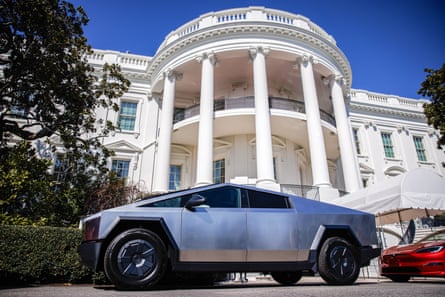
The Cybertruck answers a question no one in the auto industry even thought to ask: what if there was a truck that a Chechen warlord couldn’t possibly pass up – a bulletproof, bioweapons-resistant, road rage-inducing street tank that’s illegal to drive in most of the world?
Few had seen anything quite like the Cybertruck when it was unveiled in 2019. Wrapped in an “ultra-hard, 30X, cold-rolled stainless steel exoskeleton”, the Cybertruck was touted as the ultimate doomsday chariot – a virtually indestructible, obtuse-angled, electrically powered behemoth that can repel handgun fire and outrun a Porsche while towing a Porsche, with enough juice leftover to power your house in the event of a blackout. At the launch, Tesla CEO Elon Musk said the truck could tackle any terrain on Earth and possibly also on Mars – and all for the low, low base price of $40,000. “Sometimes you get these late-civilization vibes [that the] apocalypse could come along at any moment,” Musk said. “Here at Tesla, we have the best in apocalypse technology.”
Six years on, Covid and Musk’s political alignment with Donald Trump have kicked up the apocalypse vibes, and Tesla’s good sense has only become more questionable as the Cybertruck has been reduced to an object of universal scorn and derision further raising a host of questions: is the Cybertruck even a decent doomsday chariot? Could it really survive end times? Will it survive Musk himself? “There’s no doubt it’s a heavy-duty vehicle that can take some punishment, even from small arms fire,” says Arthur Bradley, a prepping expert who oversees the building of satellite systems at Nasa’s Langley research center in Virginia. “But you can’t weigh the pros without also asking: ‘Are people shooting at me because they think I’m an idiot or a bad guy, or they don’t support my political views – or they don’t support me supporting this company?’”

Post-armageddon transport has a simple but specific brief: be tough, durable and drive through anything – and no vehicle ticks those boxes more reliably than trucks. Fictional concepts such as Mad Max’s tanker-based War Rig are often the inspiration for real-world creations like Ford’s custom-built F650 Supertruck, a tractor-trailer sized monstrosity that can carry 120 gallons of fuel, tow 30,000lbs, and be reinforced with bulletproof armor. The truck is how insurgent fighters get around war zones and what storm chasers use to run down tornadoes. “They’re certainly pretty good for prepping purposes,” says Sean Gold, a former air force emergency manager who has worked in the prepping industry for nearly a decade. “They’re large, off-road capable, able to get off roads that might be congested – that sort of thing.”
The Cybertruck, however, broke from a century’s worth of truck-building orthodoxy, eschewing the typical three-box layout for a wedge-shaped silhouette that took inspiration from the movie Blade Runner and cyberpunk motifs. It mocked the F-150, the US’s top-selling vehicle for the last 47 years, as prehistoric tech. On its website, Tesla featured imaginative images of the Cybertruck crawling around Mars. Few knew what to make of it. Simone Giertz, a DIY robotics inventor who built a Tesla truck on her popular YouTube channel, was among a select group invited to Tesla’s Hawthorne, California, studio for the Cybertruck unveiling. “I have never physically felt the air leave a room in the way that it did when the Cybertruck rolled out on stage,” she recalls. “People were so confused.”
Since Musk’s hard-right turn, however, the Cybertruck’s design has gone from aesthetically polarizing to politically so. A recent Slate article nods at the truck’s uncanny resemblance to the Casspir, the apartheid-era military transport that patrolled South African townships in Musk’s boyhood. “As violence and flames engulfed the streets of the nation, Black South African children drew and wrote about the apartheid security forces and its tools – dogs and Casspirs – chasing and shooting at them in their schools, streets, and homes,” the article says. “By the 1990s, the Casspir had become an iconic global symbol of apartheid oppression.”

It’s no surprise then that the Cybertruck would become a status symbol for security forces. One California police department spent $153,000 on a Cybertruck for “community outreach efforts” (though it didn’t rule out using it to “respond to emergencies” as needed), and a Chechen warlord showed off a machine-gun mounted Cybertruck he claimed was purpose-built to help his army fight alongside Russia in the Ukraine war. “I am sure that this ‘beast’ will bring a lot of benefit to our fighters,” Ramzan Kadyrov said while heaping praise on “the respected Elon Musk”, who has denied making the vehicle for Kadyrov. Ultimately, the Cybertruck had to be towed from the battlefield after randomly shutting down on Chechen forces, and Kadyrov accused Musk of switching it off remotely – a nagging concern among Tesla owners.
In Tesla’s early days, the catastrophe thinking was small – a “bioweapon defense mode” button on each vehicle’s climate control, something Musk reckoned might come in handy “if there’s ever an apocalyptic scenario of some kind”. But even as Musk’s winking references to the apocalypse manifested into a bulletproof rig made of stainless steel, there was no denying that he may have been right to think the Cybertruck could be a hit with consumers. After the 2019 unveiling, Tesla received around 2m preorders from customers plonking down $100 each. But in the end the enthusiasm wouldn’t last because Musk couldn’t keep his promises.
The Cybertruck came to market two years too late, which was time that allowed Tesla’s rivals to get in the game; more Cybertruck reservation holders might have hung in there if Musk hadn’t marked the truck’s base price up to $99,000. Perhaps most detrimental for Tesla: the Cybertruck’s purported utility appeared to be worse than advertised. The average truck is undergirded with a steel frame to handle the rigors of hauling and towing – but the Cybertruck’s underbody is made of aluminum, much lighter metal that can bend and even break under heavy strain. Stainless steel is also susceptible to rust – which is to say the Cybertruck is an iffy proposition to survive regular winter, let alone nuclear winter.
The internet teems with video of the Cybertruck spinning its wheels in a snowy parking space, on the beach and further off the beaten path; meanwhile the Rivian R1T, a legitimately capable electric vehicle rival to the Cybertruck, was apparently no worse for wear after being tossed around during Hurricane Helene. (“What a dream marketing opportunity for Rivian,” Giertz says. “Your truck actually survived a natural disaster.”)
Dan Neil, the Wall Street Journal’s Pulitzer prize-winning car critic, slid off a hill while test-driving the Cybertruck with his teenage daughter. “We took it on class three and class four trails, which it is technically capable of,” he says. “But it’s also 2ft wider than any trail at any national park could generally accommodate. That’s the part I don’t get. It’s definitely an on-road car.”

That makes the Cybertruck an even tougher sell to doomsday preppers – many of whom already had their doubts about the viability of EV technology during and after a major disaster, says Gold, the former air force manager. The Cybertruck’s 300ish-mile range in particular becomes a much riskier proposition when plugs stop working. “The beauty of EVs is you don’t have to hunt for fuel,” says Bradley, the Virginia-based prepping expert. “But the drawback is most people don’t have a large solar power generation system. If you get a little too far out, or run into a situation that causes you to use up your energy, you might not get back home.”
Daisy Luther, a former automotive service manager who went into the prepping business after the 2008 financial collapse, wonders how anyone in the post-apocalypse would go about fixing a Cybertruck (which has already been recalled eight times) – especially in the event of an electromagnetic pulse or similar event. “I generally recommend that if someone is getting a vehicle to last them through some kind of apocalyptic situation that it have as few computer chips and electronics as possible,” says Luther, who drives an old Jeep. “I can do small repairs on something mechanical, but I can’t do anything that requires a computer flash or a satellite upgrade because I don’t have the equipment.”
Last month I rented a Tesla Cybertruck to get a feel for it as a family vehicle and found it to be ill-equipped for these times, let alone the end times. (And I say that as the owner of a Model Y, an exceedingly versatile family hauler that’s also massively fun to drive.) At over 6ft wide, 18ft long and 3.5 tons, the Cybertruck was a bear to maneuver around Atlanta’s narrow streets; its obtuse-angled shape made identifying traffic hazards through the car’s windows and mirrors a virtual impossibility. Even when I find myself considering the Cybertruck just for its potential as a standby home generator, I was soon reminded that Hyundai and Kia EVs offer similar capability for a fraction of the cost.
For my toddler boys the Cybertruck is what the Lamborghini Countach was to me in my youth, the apogee of poster cars – but the truck isn’t what I would call kid-friendly. Mostly, it kept me worried about them gouging out an eye, losing a finger or getting static shock from touching the steel doors as they explored.
“You’re driving a meme car!” Ezra Dyer, the Car and Driver columnist, helpfully reminds me. “You have to buy into the idea that it’s kind of funny, wink-wink.” When my wife asked if the children would be safe inside, I hesitated to tell her that Alijah Arenas – the highly regarded USC basketball recruit and son of former NBA All-Star Gilbert Arenas – had to be put into a coma after losing control of his Cybertruck and crashing into a fire hydrant in Los Angeles. Suffice to say, had Alijah Arenas been driving a Rivian (the safest pickup on the road full stop) or Tiger Woods’s 2009 Escalade, he would have been able to walk away from the accident; but somehow, bystanders managed to pry open the Cybertruck’s doors, which don’t have exterior handles (!), and pull him away from a fiery scene made scarier by the truck’s tough to extinguish high-voltage battery – the last thing you’d want to deal with when the world’s already burning.

Unlike modern cars, the Cybertruck was expressly not designed to deform on impact – further ratcheting up the safety risks during and after a cataclysmic disaster. (This is also why Cybertrucks are banned in the UK, EU and China, the world’s largest EV market.) Gold, who drives a Model 3, could envision a bad actor hacking into the truck remotely or even Musk himself shutting them down out of spite as may or may not have been the case with the Chechen warlord. “I know it doesn’t really make sense [for him to do that],” Gold says, “but the possibility is concerning”.
Then there’s Gold’s point: the Cybertruck is such a ripe target, it sticks out so much. Early on Ford CEO Jim Farley dismissed it as the kind of status mobile you might find “parked in front of a hotel”. In its relatively short life, the Cybertruck has gone from being a status mobile for Kim Kardashian, Pharrell Williams and other tastemakers to the ultimate meme-mobile – a Maga hat on wheels. (SNL’s Colin Jost called it the answer to the question: “What if Kanye was a car?”) When the truck isn’t being flipped off in traffic (although that wasn’t my experience driving it in Atlanta, a saturated Tesla market), it’s being used as a slate canvas for political protests against Musk. “I mean, I wouldn’t want to drive one around town today,” Bradley says.
Read more from The Armageddon complex series
The irony of Tesla’s apocalypse machine is it couldn’t even overcome Musk’s worst nature, or even live up to the earth-saving principles that Tesla used to espouse. “Maybe this explains it: he’s working really hard on bringing down civil society; maybe that was just to increase the market?” Giertz jokes. “It’s interesting because when the environmentalists turned on Elon, he immediately pivoted to another target group: the preppers who want to be self-sufficient. But at this point when civility is out the window and we are even more pissed at the guy who brought the apocalypse in, I’d rather be in a Toyota Prius than a Cybertruck.”
On the company’s earnings call last month Musk vowed to step back from running the so-called “department of government efficiency” (Doge) to devote more time to Tesla amid speculation that he could be replaced as CEO – but the catastrophe might unsalvageable. “I don’t think that [Doge] is the issue,” Ross Gerber, a major Tesla investor, told CNN. “Actually, it’s that people despise Elon Musk even more than they hate Trump. And that’s not something that he can solve at this point.”
Despite being the world’s top selling EV pickup, Cybertruck sales are still so poor that the company doesn’t even bother reporting them – but record high inventory and steep depreciation curves gives the game away. Quietly, Tesla shifted marketing strategies for the Cybertruck, pivoting away from the martian imagery to more classic pickup truck iconography – but it’s too little, too late, and now just gaslighting the public. In recent months Tesla’s board chair made $198m unloading the company’s stock amid falling profits. Ford, Rivian and other competitors are fast gaining ground in the market. “It’s really interesting to see how far Tesla has fallen,” says Benoit. “At this point it’s beyond political.”
If anything, the Cybertruck becoming the Titanic of cars is the fate we actually should’ve prepared for. History tells us anytime a vehicle is touted as future-proof, it’s all but doomed to become a monument to unchecked hubris. “My guess is this incarnation of the Cybertruck has a very limited life,” Bradley says. “I think there will be another Cybertruck, but it will probably be more modern-looking – like a regular pickup truck.”

 4 hours ago
5
4 hours ago
5













































